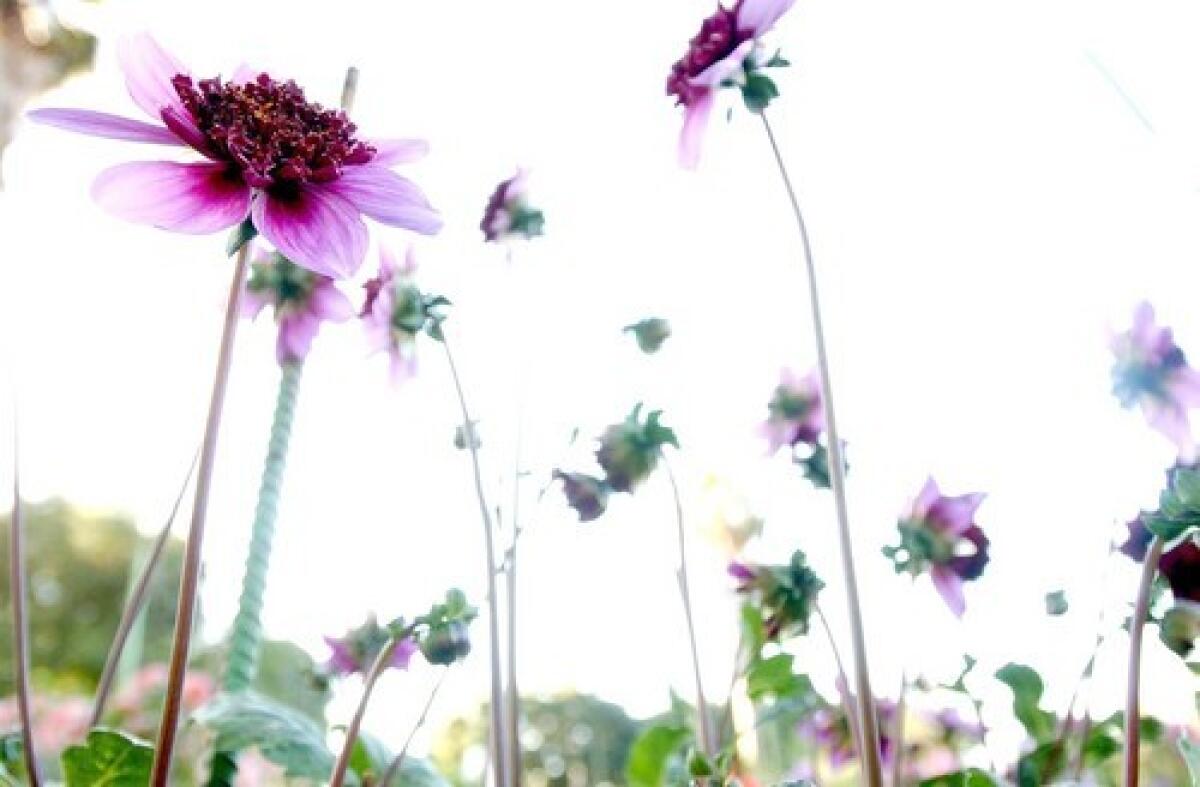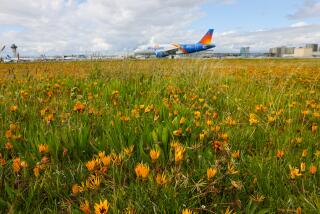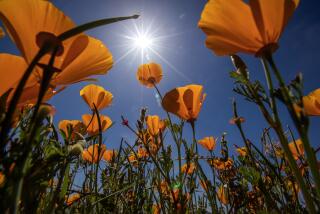Dahlias: one flower, infinite beauty

- Share via
DAHLIA aficionado Pat Cunningham likes to say he has either 40 years of experience or one year of experience 40 times over. Either way, he has grown hundreds of varieties of the flower in his Manhattan Beach garden and developed his own hybrids, including the 12-inch-wide, white-and-deep-pink ‘Shiloh Noelle’ praised by Martha Stewart.
Yes, dahlias do need attention, Cunningham says, but even beginners can expect stunning flowers.
“Do good or bad and it all comes out the same,” he says. “I won best in show as a novice.”
Therein lies the true beauty of the dahlia: its ability to flourish in Southern California and the abundance and diversity of its glorious blooms. Experts believe that all modern dahlia hybrids -- an astonishing 58,000-plus varieties at last count -- are derived from only two of three species that made their way from Mexico to Spain in 1789 and to other parts of Europe in the early 1800s, where they were hybridized.
Today, most collectors shun local bulb sources, especially big-box stores. Instead, they trade with other hobbyists and buy from specialty growers in Oregon and Washington.
“It’s dahlia heaven up there,” says Dick Kohlschreiber of San Pedro. He and other members of the South Coast Dahlia Society maintain a collection of 150 varieties at the South Coast Botanic Garden on the Palos Verdes Peninsula. “We can grow beautiful dahlias, but it’s more of a struggle in this climate.”
Although dahlias require warmth, Southern California’s intense summer sun makes them swoon. For this reason, most collectors live along the coast.
Mae and Bruce Keith grow dahlias at their Palos Verdes Estates home -- she for 54 years, he since retiring 25 years ago. They planted “only” 40 varieties this year. “They’re beautiful and lovely to show, but you can’t just stick them in,” Mae says. “You have to cultivate, stake, fertilize, spray for diseases and insects, disbud to one flower per stem.”
When scorching days precede a show, the Keiths shade the flowers -- especially reds, pinks and lavenders -- with beach umbrellas to prevent fading.
Saturated colors, extraordinary shapes and hypnotic symmetry are only part of what make dahlias remarkable. They’re also resilient when cut, lasting up to a week if the vase water is changed daily. (Devotees insist that dahlias must be harvested often for repeat bloom.) Alas, the only thing they seem to lack is fragrance.
The genus Dahlia belongs to the daisy family, or Asteraceae, characterized by composite flowers with a center of disk florets surrounded by petal-like ray florets. Cosmos, coreopsis and bidens are its closest relatives.
All 35 Dahlia species are native to the highlands of Mexico and Central America, where volcanic soil and nutrient-rich forest debris promote rapid growth during warm, wet months. Most are low- to medium-size perennials with green or red-purple foliage that dies in winter.
One rare species, D. macdougalii, is an epiphyte (air plant) that scrambles over rain forest trees and festoons them with long roots. The so-called tree dahlia, Dahlia imperialis, one of the few species available to gardeners, is a gigantic tropical herb with huge divided leaves, bamboo-like stems that can surge to more than 20 feet in one season, and lavender or white flowers in November.
The Aztecs called the dahlia “acocotli” and “cocoxochitl” and used the tubers, often called the “roots,” for food and medicine. Francisco Hernandez, who sailed from Spain to Mexico in the 16th century, wrote that roots of the dahlia tasted “smelly, bitter and sharp ... hot and dry in the third degree.” Europeans of that period were not interested in it.
But during the 19th century, a period dubbed “dahlia-mania,” European breeders produced thousands of hybrids. Dahlias, plant breeder Cunningham explains, have 64 chromosomes, far more than most flowers. The complicated genetics provide seemingly infinite variation.
The ball-shaped dahlia, perfectly rounded with dozens of ray florets swirling out from a tightly closed center, was developed in 1818. It was followed by the pompon, the cactus, the anemone, the peony and the waterlily. Star and orchid emerged in the 20th century, along with floriferous dwarf dahlias ideal for bedding and containers.
The American Dahlia Society’s classification system -- the so-be-it of judged dahlia shows -- identifies 19 flower forms, nine sizes (from less than 2 inches to more than 10) and 15 colors (no blue or black).
Dahlia tubers are modified underground stems that store water and nutrients during lean times. They are elongated like potatoes but with a single “eye” at one end.
Planted in spring and grown kindly, dahlia tubers work their magic, yielding foliage, buds and blossoms in 60 days. They can grow and flower through the long days of summer into autumn.
Dahlias prefer well-amended, fast-draining soil; raised beds are strongly advised. During the growing season, these leafy plants also need plenty of fertilizer and water. Think daily irrigation plus overhead spritzes during a heat wave. “They’re heavy feeders,” Kohlschreiber says. “We usually recommend a high-nitrogen fertilizer until the buds are formed and showing some color. Then we switch to a ‘high bloom’ formula, such as 2-10-10.”
Dahlias are popular with insects, snails, fungi and other pests. Some gardeners use chemical sprays and systemics. Others find that organic and biological controls work as well or better. At the South Coast Botanic Garden, container plants have been sunk into the ground, so gophers can’t get to the roots.
To avert trouble, Kohlschreiber suggests leaving at least 2 1/2 feet between plants. “Provide plenty of air circulation,” he says, “and you’ll have less trouble with bugs and powdery mildew.”
Timing is also crucial.
“In the Los Angeles area, tubers and cuttings should be planted after April 1,” he says. “If the soil temperature is cold, they’ll sit there and rot. In San Diego, they plant March 1; from Santa Barbara north, after May 1.”
To get a jump on the season, Tim Scott, a Hancock Park resident with 350 varieties of dahlias, starts tubers in flats in mid-February and moves them to the garden in April.
Because dahlias propagate easily, hobbyists often have tubers and cuttings to share with other gardeners. Scott grows dahlias at home and on the nearby grounds of the Third Street School. With more than 1,000 dahlias to care for between his two gardens, he rarely digs and divides before February.
“The only reason I dig them up,” Scott says, “is so I can share them with others.”
Bob Papp, president of the South Coast Dahlia Society, plants his extras in willing neighbors’ yards in Long Beach and envisions a “dahlia at every hole” of his golf course.
Vicki Hutter tends 300 dahlia plants under 30% shade cloth on a 2-acre avocado ranch in Somis. She takes the flowers to her quilt shop, doctor’s office, husband’s office and church. Summer mornings, she spends two hours with her dahlias. Each year she swears that she won’t expand the collection -- but she does.
“Those ugly tubers -- you put them in the ground and get these gorgeous flowers,” she says. “Every year, it just astounds me.”
INFOBOX
Dahlias’ day in spotlight
These flowers need rich soil, excellent drainage, ample spacing and plenty of sun, water and fertilizer during the growing season. Tubers and cuttings planted in April will flower from July through October.
Show: The South Coast Dahlia Show and Pacific Southwest Dahlia Conference runs noon to 4:30 p.m. Aug. 20 and 9 a.m. to 4 p.m. Aug. 21 at the South Coast Botanic Garden, 26300 Crenshaw Blvd., on the Palos Verdes Peninsula; (310) 544-1948. Admission to the show is $5 to $7.
Resources: “Encyclopedia of Dahlias” by Bill McClaren (Timber Press, 2004). The American Dahlia Society operates eight trial gardens, the closest of which is in Tacoma, Wash. Its website, www.dahlia.org, has useful links, including one to the “Big List,” a compendium of dahlia varieties and commercial sources that sell them.






